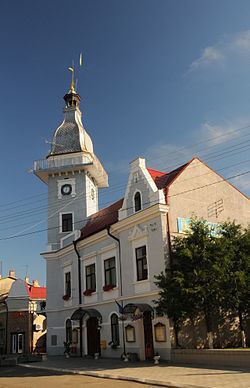First mention 1448 Time zone EET (UTC+2) Area 5.8 km² Local time Tuesday 10:25 PM | Elevation 366 m (1,201 ft) Postal code 59000 — 59004 Population 14,506 (2011) | |
 | ||
Weather 11°C, Wind W at 13 km/h, 52% Humidity | ||
Storozhynets (Ukrainian: Сторожи́нець, [stɔrɔˈʒɪnɛt͡sʲ], translit. Storožýnec’, see other names below) is a small city located in Chernivtsi Oblast of western Ukraine, north of the border with Romania. It is the administrative center of Storozhynets Raion and is located approximately 20 km (12 mi) south-west of the oblast capital, Chernivtsi.
Contents
- Map of Storozhynets Chernivetska oblast Ukraine
- Other names
- History
- 1930 Romanian Census
- Famous people
- References
Map of Storozhynets', Chernivets'ka oblast, Ukraine
Storozhynets is located in the historic region of Bukovina, which has been governed by Moldavia (before 1774), the Austrian empire (1774–1918), Romania (1918–1940 and 1941–1944), the USSR (1940–1941 and 1944–1991) and Ukraine (since 1991).
Other names
Other names for the city include:
History
Storozhynets was a part of the Principality of Moldavia and was first mentioned in 1448. The first inhabitants were a settlement of loggers. In 1774 Austria added the Duchy of Bukovina to its territories. It was marked with great changes as Austrians and Germans arrived en masse. There were schools with German, Romanian, and Ukrainian as their languages of instruction.
Since the second half of the 19th century, a rapid population growth began with the arrival of Jews to the city, as well as Hungarian and Romanian businessmen, legal and banking officials most of whom were Jews. In 1854 Storozhynets received the status of city. By the end of the 19th century and early 20th century, the city was populated mainly by Jews.
In 1903 in Storozhinets opened a private school. In May 21, 1904 Storozhynets became a county. Trade, industry, agriculture, science, education and culture have developed a rapid pace.
But after World War I, its territory ended with a new status as Northern Bukovina became part of the Kingdom of Romania. In 1921, Romanian became the official language, and Ukrainian language was not used any more in the administration.
In 1940, 28 June, Northern Bukovina was occupied by the Soviet troops. After the start of the war against the Soviet Union, in 1941 Northern Bucovina was reintegrated into the Kingdom of Romania.
Between 1941 - 1943 a great part of the Jewish population was killed or deported to concentration camps in Transnistria.
1930 Romanian Census
Total 8,695
